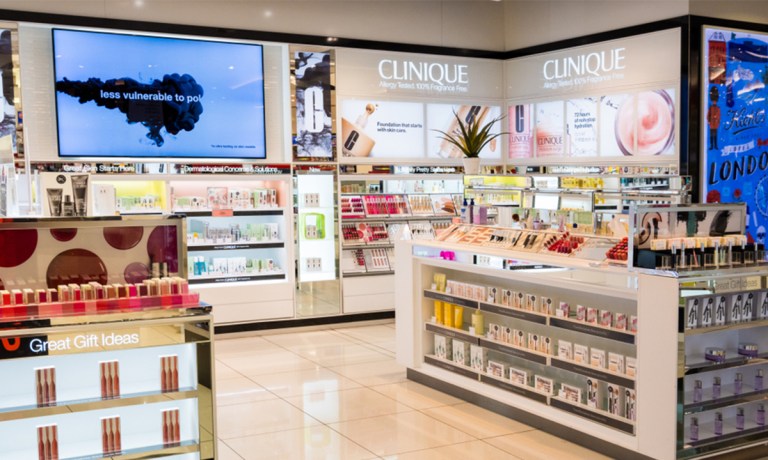
Free items, giveaways, goodie bags, and “gift with purchase” — whatever you choose to call them, all radiate an allure within the retail sphere as they entice consumers into making purchases and exploring new products.
It’s a strategy that has been employed since the mid-20th century.
The story of gift with purchase dates back to the 1950s, when cosmetics brand Estée Lauder introduced what could be considered as a revolutionary marketing concept.
Estée Lauder offered customers a free cosmetic bag filled with product samples upon purchasing a fragrance. The move not only drove sales but also introduced consumers to products they might not have otherwise considered. This marked the beginning of a trend that would reshape the retail industry.
“It’s a wonderful way to give the consumer an opportunity to try a product and get comfortable with it before she actually makes a commitment to use it,” said Jackie Kelly, director of promotional marketing for Clinique, an Estée Lauder subsidiary, in the 2000s. “More importantly, though, one of the main things we hope it does is introduce new users to the brand.”
The gift with purchase technique has the potential to impact consumer behavior, mindset, spending patterns, and brand allegiance.
To begin with, individuals frequently gravitate towards products or services that present a sense of value. Gift with purchase capitalizes on this notion by elevating the overall value proposition. The consumer is encouraged to make a purchase they might not have otherwise considered.
Consumers are more likely to spend more than they initially intended in order to qualify for the free gift. In light of this, brands and retailers can strategically define minimum purchase requirements that incentivize customers to increase their expenditures to get the gift.
Brands can also use the gift with purchase strategy to acquaint consumers with associated products or motivate them to consider premium alternatives.
Being surprised with an unexpected gift elevates the overall shopping journey, imprinting a favorable memory in the customer’s mind. This can become an enduring loyalty and recurrent buying behavior.
In addition, brands establish an emotional bond with consumers. These customers often connect positive emotions with the brand, increasing the probability of their return for future transactions.
Yet, in periods of inflation, retailers encountered difficulty in rationalizing giveaways, given the rising expenses associated with shipping, returns, and all other aspects of business operations.
In May, PYMNTS reported that Sephora would be doing away with its birthday freebies. To obtain the complimentary birthday perk, customers were obliged to make a minimum online purchase of $25. Nevertheless, customers retained the ability to redeem their birthday gift at Sephora stores without being obligated to meet any minimum purchase criteria.
The most recent update came about six months after another alteration to its birthday gift benefit, which had restricted the annual dispatch of birthday gifts to a single address.
In November, Sephora put a cap of 150 birthday gifts that could be delivered to a single address within a year. This limit applied to various locations, including residential and office premises, as well as package forwarding services. The company voided any orders that exceeded this threshold.
Read more: Sephora Asks Customers to Pay $25 for Their Own Birthday Perk
However, even though Sephora has introduced changes, the perk remains. By incentivizing customers to visit their physical stores, Sephora offers an opportunity for customers to personally test, experience, and interact with products — an engagement that isn’t possible through online channels.
However, the gift with purchase approach can serve as more than just an incentive for additional purchases. It has the potential to draw a broader audience and educate consumers as well.
This week, PYMNTS reported that Estée Lauder had been leaning into new strategies to engage consumers, which included TikTok, as well as tried-and-true methods like emphasizing its scientific approach — incorporating dermatologist-developed, allergy-tested formulations — and expertise — tapping dermatologists and academic experts — and its gift with purchase incentive.
Read more: Estée Lauder Embraces Science, Expertise and TikTok to Get Consumers to Shop
However, omitted from the report was the beauty company’s endeavor to integrate brands beyond the realm of beauty into the equation.
In June, Clinique brought fashion into the mix with its gift with purchase and teamed up with Kate Spade. The partnership introduced a range of lip glosses that will complement its gift with purchase program, accessible through clinique.com, Macy’s, and Belk in the United States, as well as Shoppers in Canada.
The move follows a recent endeavor by Herbivore, a brand focused on clean beauty, who during April initiated a special collaboration with the digital mental health platform Real.
The collaboration centered on Herbivore’s recent product, the Aquarius Cleanser designed for individuals with acne-prone skin. The joint campaign, named “Be Kind To Your Pores + Be Kind To Yourself,” aimed to promote both the new cleanser and prioritize mental well-being. The cleanser was introduced to the market in March, followed by coordinated promotional content on social media and an accompanying social media giveaway.